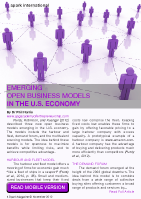Purdy,
Robinson, and Kuangyi (2012) described three new open business
models emerging in the U.S. economy. The models include the harbour and fleet,
demand forum, and the multivalent sourcing models. The idea behind these models
is for openness to maximize benefits while limiting risks, and to achieve
competitive advantage.
The
harbour and fleet model offers a mooring of firms for economic gain much
"like a fleet of ships in a seaport" (Purdy
et al., 2012, p. 36). Small and medium-sized
businesses that keep their fixed costs low comprise the fleet. Keeping fixed
costs low enables these firms to gain by offering favorable pricing to a large
harbour company with excess capacity. A prototypical example of a harbour company
is www.amazon.com. A harbour company has the advantage of buying and delivering
products much more efficiently than competitors (Purdy
et al., 2012).
The
Demand Forum
The
demand forum emerged at the height of the 2008 global downturn. The idea behind
this model is to combine deals from a wide range of collective buying sites
offering customers a broad range of products and services by bundling them.
Yipit is a firm targeting deals for specific consumer groups from places like
GroupOn and Tippr. Yipit is a clearinghouse that offers mutually worthwhile
exchanges by matching buyers with sellers (Purdy
et al., 2012).
Multivalent
Sourcing
(Purdy
et al., 2012) described multivalent sourcing as
a strategy connecting multiple bonds of stakeholders in production. The model
controls the supply of materials, talent, innovation, and capital to develop
informational exchanges and improve bargaining power over market inputs. Prime
Advantage serves as an example. Prime Advantage profits by offering group
buying services and negotiating discounts with different merchants. Prime
Advantage is a subscription service offering members access to raw materials,
components, and business services at reduced rates through a pool of suppliers.
Suppliers benefit from access to a broader number of customers that pay a fee
to subscribe to the service.
This
model allows customers to overcome informational challenges in finding suitable
source goods, services, capital, and ideas in an efficient way at low prices.
Another benefit of this model is to connect innovators with firms that can use
them in efficient ways (Purdy
et al., 2012).
Advantages
of the Open Business Models
Open business models have
the advantage of scalability across borders by reducing barriers to entry into new
geographic markets. For example, the harbour and fleet model standardizes
logistical arrangements and keeps supply-chain risks to a minimum. The open
business models allow companies to tap into global demand from expanded buying
power. Companies have improved access to the factors of production allowing
them to improve quality at a lower cost. Another advantage of the open business
model allows companies to tailor the factors of production to business needs (Purdy
et al., 2012).
Challenges
of the Open Business Model
(Purdy et al., 2012) characterized the open business
model as largely network-based. Because the open business model depends on a
network, it carries a responsibility to pay close attention to the quality of
the participants and their character to ensure cooperation exists. These
relations are important for cross-cultural competencies. The firm must ensure
it links the proper network participants with key customers.
A firm
employing an open business model can face more complex demand patterns across
borders than in the firm's home market or in regional applications. However, a
firm can overcome the problem by grouping customers according to buying power
and cultural backgrounds. Another approach is for a firm to adopt a hybrid
approach by setting up a physical presence to gather information and improve
data analysis. Copying the model poses another challenge because it can
cause a firm to lose intellectual property. A firm should consider the locality
and its laws to prevent losses (Purdy
et al., 2012).
The
harbour and fleet model, the demand forum, and the multivalent sourcing model are some of the newest open business models sweeping the U.S. economy. Each of
these models have advantages and challenges to consider before deciding on
which is proper for a firm to employ.
By
J. Phillip “Phil” Harris, D.B.A.
Dr. Harris is the founder and principal of Acclaimed Professionals Group. Dr. Harris is an experienced business entrepreneur, a certified public accountant, and teaches at the University of Phoenix. He is also a member of Delta Mu Delta honor society and has a Masters of Business Administration in finance.
References
Purdy, M., Robinson, M. C., & Kuangyi, W.
(2012). Three new business models for "the open firm". Strategy &
Leadership, 40(6), 36-41. doi: 10.1108/10878571211278877

